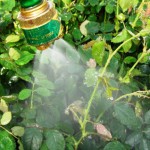 Mechanical practices are the first practices to consider when pests have reached an unacceptable level (action threshold). They include erecting barriers, using traps, hand-picking and other activities that disrupt insect breeding and feeding. For instance, spraying plants with a water hose to knock off aphids and mites is a mechanical practice. Mechanical practices include:
Mechanical practices are the first practices to consider when pests have reached an unacceptable level (action threshold). They include erecting barriers, using traps, hand-picking and other activities that disrupt insect breeding and feeding. For instance, spraying plants with a water hose to knock off aphids and mites is a mechanical practice. Mechanical practices include:
Sanitation
Keep the landscape clean and free of scenarios that might attract insect pests. This includes removing unwanted debris in contact with the ground, dead limbs, piles of decomposing organic matter and eliminating standing water that are not landscape design elements.
Control Abiotic Elements
Many nuisance pests are present due to physical characteristics of the local environment. Piles of rocks, deposits of leaf litter, and presence of ground debris are favorable habitats of creatures like snails and slugs, sowbugs and pillbugs, centipedes and millipedes, and scoropions. When there elements left undisturbed, populations of there organisms may persist. Presence of shade, moisture, and structure (cracks and crevices) profoundly affect arthropod populations favored in those habitats.
Other Mechanical Methods
Other mechanical methods for insect control include hand destruction, exclusion of pests from plants using fine mesh screens (Bug Block, Visqueen and others) or other types of barriers. Tanglefoot® is a petroleum-based sticky material often used to make sticky barriers that are difficult for insects to cross. This material is available as both a gel and a spray. This material can be used to make yellow sticky cards as well. Newer products containing Teflon® either as a tape or as a spray may also be useful for similar purposes.
Use of high pressure water sprays, using special equipment such as the Water Wand or the Jet-All, can remove small insects and mites from foliage. Rose growers report good results using such devices. However, care must be taken in certain situations. In some cases, spraying mites off one hose only serve to spread infestations to alternate hosts nearby. On the other hand, for host specific wingless pests such as the crape myrtle aphid, these devices can be an effective method for temporary suppression of pest numbers. In addition, the high pressure sprays can remove some of the honey dew that can lead to hard-to-remove sooty mold.
In turfgrass area, mowing height and frequency can affect some pest population levels. Red imported fire ants generally migrate away from frequently disturbed area. For Bermudagrass stunt mites (eriophyid mite), where there are no available insecticidal/miticidal control products, cultural practices as follows: an infrequent scalping to remove ca 98% of the infestation; remove clippings from the area (they are full of mites) and destroy off-site; grow the grass ahead of the mites with adequate H2O and fertilization (personal communication Dr. Jim Reinert, 2011).
Related
Mechanical Pest Controls – Oklahoma Cooperative Extension Service
Next >>>IPM Practices: Chemical
